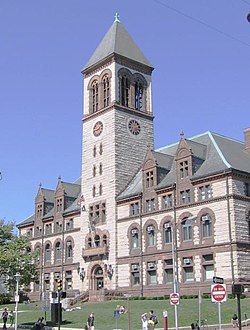
Inman Square is a neighborhood and historic district in Cambridge, Massachusetts. It lies north of Central Square, at the junction of Cambridge, Hampshire, and Inman Streets near the Cambridge–Somerville border.

Central Square is an area in Cambridge, Massachusetts centered on the junction of Massachusetts Avenue, Prospect Street and Western Avenue. Lafayette Square, formed by the junction of Massachusetts Avenue, Columbia Street, Sidney Street and Main Street, is also considered a part of the Central Square area. Harvard Square is to the northwest along Massachusetts Avenue, Inman Square is to the north along Prospect Street and Kendall Square is to the east along Main Street. The section of Central Square along Massachusetts Avenue between Clinton Street and Main Street is designated the Central Square Historic District, and was added to the National Register of Historic Places in 1990.
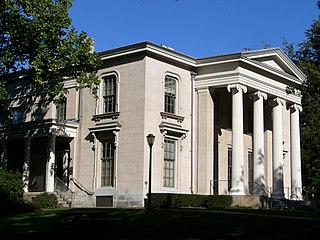
Hillhouse Avenue is a street in New Haven, Connecticut, famous for its many nineteenth century mansions, including the president's house at Yale University. Both Charles Dickens and Mark Twain have described it as "the most beautiful street in America." Much of the avenue is included in the Hillhouse Avenue Historic District, which extends to include houses on adjacent streets.

The Cambridge, Massachusetts City Hall is the city hall for Cambridge, Massachusetts, located at 795 Massachusetts Avenue, and built in the Richardsonian Romanesque style. The building additionally serves as a centerpiece of the surrounding City Hall Historic District and adjacent Central Square Historic District.
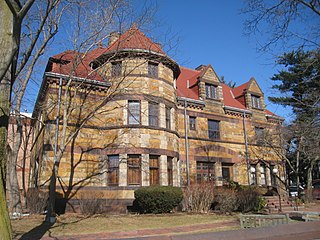
The Edwin Abbot House, also known as the Zabriskie House, is an historic house at 27 Garden Street in Cambridge, Massachusetts. Built in 1889 to a design by Longfellow, Alden & Harlow, it is a prominent local example of residential Richardsonian Romanesque architecture. It has served as the principal building of the Longy School since 1937. It was listed on the National Register of Historic Places in 1979, and included in the Follen Street Historic District in 1986.

The Bigelow Street Historic District encompasses a uniform collection of 19th century houses on most of the length of Bigelow Street in Cambridge, Massachusetts, just northwest of Central Square. Bigelow Street was laid out in 1868, and the street was almost completely built out by 1874, resulting in a fairly uniform streetscape of Second Empire architecture. The district was added to the National Register of Historic Places in 1982.

The Maple Avenue Historic District is a residential historic district on Maple Avenue between Marie Avenue and Broadway in Cambridge, Massachusetts, United States. It encompasses a street with a cohesive collection of well-preserved, predominantly Italianate and Second Empire, houses, in which the original spacing and setting has been preserved. It includes houses on both sides of Maple Avenue, numbered from 8 to 33, among which stand several Queen Anne and Colonial Revival houses. The district was added to the National Register of Historic Places in 1983.

Court Square is the central plaza and historic district in Springfield, Massachusetts. It is located in the heart of Springfield's urban Metro Center neighborhood. Court Square is the City of Springfield's only topographical constant since its founding in 1636.

The Central New Bedford Historic District is one of nine historic districts in New Bedford, Massachusetts, United States. The district encompasses the city's central business district, built up during the time in the late 19th century when textiles had replaced whaling as the city's main industry. It is a 29-acre (12 ha) rectangular area bounded by Acushnet Avenue and the older New Bedford Historic District on the east, School Street to the south, Middle Street on the north and 6th Street in the west. It was added to the National Register of Historic Places in 1980.

The Park Square Historic District is a historic district in Pittsfield, Massachusetts. The district is centered on the historic heart of Pittsfield encompassing a number city blocks adjacent to Park Square, which is at the junction of North, South, East, and West Streets.
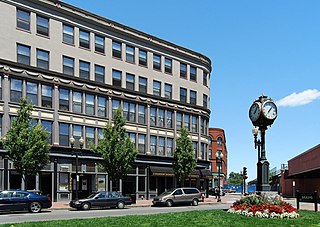
The Central Square Historic District is a historic district encompassing the Central Square area of downtown Lynn, Massachusetts. The area is at the confluence of a number of city streets, and includes buildings that border on Central Avenue, Willow Street, Munroe Street, Lake Street, Almont Street. It is a small part of Lynn's "Burned District", a large area of the downtown that was destroyed by fire in 1889. One of the first buildings built after the fire, the Bergengren Block, stands at the corner of Union Street and Central Square. It also includes the Mowers' Block, listed on the National Register in 1982.

The Marlborough Center Historic District is a historic district encompassing the civic and commercial heart of Marlborough, Massachusetts. It is centered on a stretch of Main Street between Mechanic Street to the west and Bolton Street to the east, and includes properties on adjacent streets. The center is reflective of the city's prosperity as an industrial center from the mid-19th century to the mid-20th century. The district was listed on the National Register of Historic Places in 1998.
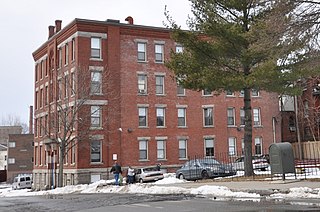
The Wellington Street Apartment House District of Worcester, Massachusetts encompasses a collection of stylistically similar apartment houses in the city's Main South area. It includes sixteen properties along Jacques Avenue, and Wellington and Irving Streets, most of which were built between 1887 and 1901. The notable exception is the Harrington House at 62 Wellington Street, a c. 1850s Greek Revival house that was virtually the only house standing in the area before development began in the 1880s.

The Central Square Historic District is a historic district encompassing much of the central business district of Stoneham, Massachusetts. It includes the town's largest concentration of 19th and early-20th century commercial architecture, in an area that developed in importance as a commercial center after the construction of the Andover-Medford Turnpike. The district was added to the National Register of Historic Places in 1990.

The Lake Linden Historic District is located in the village of Lake Linden in Houghton County, Michigan.

Hartwell and Richardson was a Boston, Massachusetts architectural firm established in 1881, by Henry Walker Hartwell (1833–1919) and William Cummings Richardson (1854–1935). The firm contributed significantly to the current building stock and architecture of the greater Boston area. Many of its buildings are listed on the National Register of Historic Places.

Bradlee, Winslow & Wetherell (1872–1888) was an architecture firm in Boston, Massachusetts. Its principals were Nathaniel Jeremiah Bradlee (1829–1888), Walter Thacher Winslow (1843–1909) and George Homans Wetherell (1854–1930). Most of the firm's work was local to Boston and New England, with a few commissions as far afield as Seattle and Kansas City.

The Barre Downtown Historic District encompasses the historic commercial and civic heart of the city of Barre, Vermont. Extending along Main Street from City Park to Depot Square, this area was developed quite rapidly in the 1880s and 1890s, when the area experienced rapid growth due to the expansion of the nearby granite quarries. It was listed on the National Register of Historic Places in 1979.

The Cleveland Commercial Historic District is a historic district located in the central business district of Cleveland, Tennessee. It was listed on the National Register of Historic Places (NRHP) in 2017.

The City Hall Historic District is a commercial and municipal historic district located along East Michigan Avenue from Monroe to Jay Streets in Battle Creek, Michigan. It was listed on the National Register of Historic Places in 1996.
